 Galileo: the Telescope &
Galileo: the Telescope &
the Laws of Dynamics
 Galileo Galilei (1564-1642) was a pivotal figure in the development of modern
astronomy, both because of his contributions directly
to astronomy, and because of his
work in physics and its relation to astronomy. He provided the crucial
observations that proved the Copernican hypothesis, and also laid the
foundations for a correct understanding of how objects moved on the surface of
the earth (dynamics) and of gravity.
Galileo Galilei (1564-1642) was a pivotal figure in the development of modern
astronomy, both because of his contributions directly
to astronomy, and because of his
work in physics and its relation to astronomy. He provided the crucial
observations that proved the Copernican hypothesis, and also laid the
foundations for a correct understanding of how objects moved on the surface of
the earth (dynamics) and of gravity.
Newton, who was born the same year that Galileo died,
would build on Galileo's ideas to demonstrate that the laws of motion in the
heavens and the laws of motion on the earth were one and the same. Thus,
Galileo began and Newton completed a synthesis of astronomy and physics
in which the former was recognized as
but a particular example of the latter, and
that would banish the notions of Aristotle almost completely from both.
One could, with considerable justification, view Galileo as the father both of
modern astronomy and of modern physics.
The Telescope

Galileo did not invent the telescope. The Dutch, notably Christine Huygens, were the first
to invent and experiment with lenses (to improve eye sight). But Galileo was the first to use the telescope to study
the heavens
systematically. His
little telescope
was poorer than even a cheap
modern amateur telescope, but what he observed in the heavens rocked the very
foundations of Aristotle's universe and the theological-philosophical worldview
that it supported. It is said that what Galileo saw was so
disturbing for some officials of the Church that they refused to even
look through
his telescope; they reasoned that the Devil was capable of making
anything appear in the telescope, so
it was best not to look through it. That is, the telescope was an instrument of the Devil.
That such was so could be no clearer than the image of the moon as it appeared through
Galileo's telescope:

For the moon was not perfect, it had blemishes and scars. A year later, when other
copies of the telescope were made, many others made sketches of the moon, concerning
its imperfect nature:

Opps  it does not appear that all of the objects in Aristotle's Universe are,
in fact, perfect. The moon has defects!
it does not appear that all of the objects in Aristotle's Universe are,
in fact, perfect. The moon has defects!
Well if the moon had defects then Saturn was way whacked out:
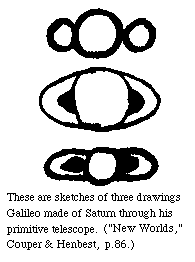
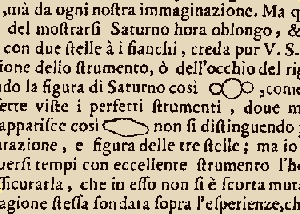
Sunspots
 Galileo observed the Sun through his telescope and saw that the
Sun had
dark patches on it that we now call sunspots
(he eventually
went blind, perhaps from damage suffered by looking at the Sun with his
telescope). Furthermore, he observed motion of the sunspots indicating that
the Sun was rotating on an axis. These "blemishes" on the Sun were contrary to
the doctrine of an unchanging perfect
substance in the heavens, and the rotation of the
Sun made it less strange that the Earth might rotate on an axis too, as
required in the Copernican model. Both represented new facts that were unknown
to Aristotle and Ptolemy.
Galileo observed the Sun through his telescope and saw that the
Sun had
dark patches on it that we now call sunspots
(he eventually
went blind, perhaps from damage suffered by looking at the Sun with his
telescope). Furthermore, he observed motion of the sunspots indicating that
the Sun was rotating on an axis. These "blemishes" on the Sun were contrary to
the doctrine of an unchanging perfect
substance in the heavens, and the rotation of the
Sun made it less strange that the Earth might rotate on an axis too, as
required in the Copernican model. Both represented new facts that were unknown
to Aristotle and Ptolemy.
The Moons of Jupiter
 Galileo observed 4 points of light that changed their
positions with time
around the planet Jupiter on a nightly basis. He concluded that these were objects in
orbit around Jupiter. Indeed, they were the 4 brightest moons of Jupiter,
which are now
commonly called the Galilean moons (Galileo himself called them
the Medicea Siderea---the ``Medician Stars''). Here is a
simulation of the
system which approximates Galileo's field of view and the poor optics of
his telescope (which is why the images are not sharp).
Galileo observed 4 points of light that changed their
positions with time
around the planet Jupiter on a nightly basis. He concluded that these were objects in
orbit around Jupiter. Indeed, they were the 4 brightest moons of Jupiter,
which are now
commonly called the Galilean moons (Galileo himself called them
the Medicea Siderea---the ``Medician Stars''). Here is a
simulation of the
system which approximates Galileo's field of view and the poor optics of
his telescope (which is why the images are not sharp).
In this simulation you can observe the "real" system of Jupiter and its moons
over the course of a 14 hour night. The simulation will pause 1/2 way through
so that you can notice the change in positions on a 7 hour timescale. The simulation then
transitions to a 10 hour day light period where Galileo is shown to have random
daytime thoughts about physics. The next night is then available and the positions of
the moons have advanced 10 hours forward and Galileo can then make another set
of observations of the configuration of the moons as he builds up his log book:
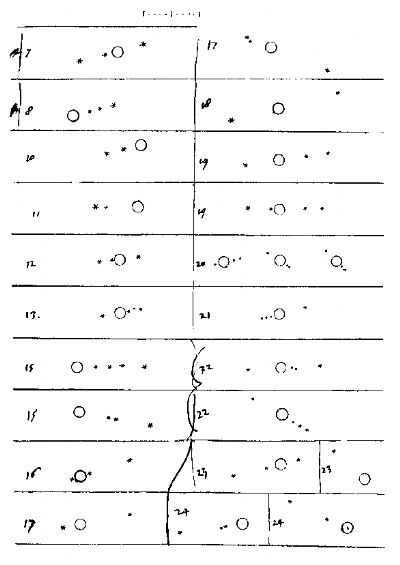
Galileo's observations were done over the course of 15 nights in January of 1610; two
of which were cloudy:
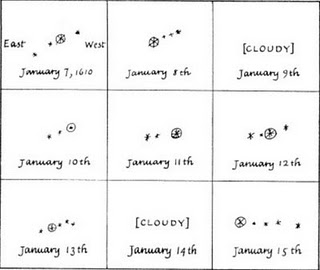

Clearly, the nightly changes in the positions of the moons relative to
Jupiter was obvious for Galileo (and anyone else that observed
the system).
These
observations again showed that there were new things in the heavens that
Aristotle and Ptolemy had known nothing about. Furthermore, they demonstrated
that a planet could have moons circling it that would not be left behind as the
planet moved around its orbit. One of the arguments against the
Copernican
system (and the original heliocentric idea of Aristarchus)
had been that if the moon were in orbit around the Earth and the Earth
in orbit around the Sun, the Earth would leave the Moon behind as it moved
around its orbit.
The Phases of Venus
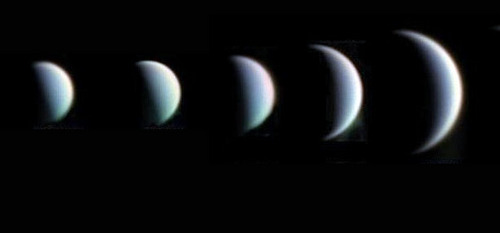 Galileo used his telescope to show that Venus went
through a complete set of
phases, just like the Moon.
Galileo used his telescope to show that Venus went
through a complete set of
phases, just like the Moon.
This observation was
among the most important in human history, for it provided the first conclusive
observational proof that was consistent with the
Copernican system but not the
Ptolemaic system.
The crucial point is the empirical fact that Venus
is never very far from the Sun, in terms of angular displacement, in our sky
Thus, as the following diagrams
indicate, in the Ptolemaic system Venus should always be in crescent phase as
viewed from the Earth because as it moves around its epicycle it can never be
far from the direction of the sun (which lies beyond it),
but in the Copernican system Venus should exhibit a
complete set of phases over time as viewed from the Earth because it is
illuminated from the center of its orbit.
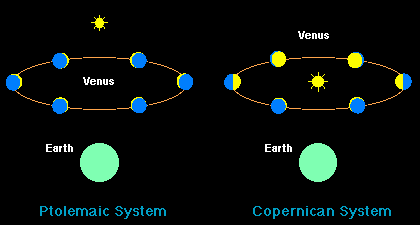 |
|
Phases of Venus in the Ptolemaic and Copernican systems
|
It is important to note that this was the first empirical
evidence (coming almost a century after Copernicus) that allowed a
definitive test of the two models. Until that point, both
the Ptolemaic and Copernican models described the
available data. The primary attraction of the Copernican system was that it
described the data in a simpler fashion, but here finally was
conclusive evidence that not only was the Ptolemaic universe more complicated,
it also was incorrect.
Myriad Observations Showing Phenomena Unknown to Aristotle
In addition to the observations noted above, Galileo made many other
observations that undermined the authority on which the Ptolemaic universe was
built. Some of these included
- Showing that the planets were disks, not points of light, as seen through
the telescope.
- Showing that the great "cloud" called the Milky Way (which we now know to
be the disk of our spiral galaxy) was composed of enormous numbers of stars
that had not been seen before.
- Observing that the planet Saturn had "ears". We now know that Galileo was
observing the rings of Saturn, but his telescope was not good enough to show
them as more than extensions on either side of the planet.
- Showing that the Moon was not smooth, as had been assumed, but was covered
by mountains and craters.
As each new wonder was observed, increasing doubt was cast on the prevailing
notion that there was nothing new to be observed in the heavens because they
were made from a perfect, unchanging substance. It also raised the
credibility issue:
could the authority of
Aristotle and Ptolemy be trusted concerning the nature of the
Universe if there were so many things in the Universe about which they had been
completely unaware?
Galileo and the Leaning Tower
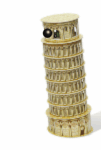

Galileo made extensive contributions to our understanding of the laws governing
the motion of objects. The famous Leaning Tower of Pisa experiment may be
apocryphal. It is likely that Galileo himself did not drop two objects of very
different weight from the tower to prove that (contrary to popular
expectations) they would hit the ground at the
same time. However, it is certain that Galileo understood the principle
involved, and probably did similar experiments. The realization that, as we
would say in modern terms, the acceleration due to gravity is independent of
the weight of an object was important to the formulation
of a theory of gravitation by
Newton.
Galileo also did experiments on projectile motion to clearly show just how
wrong the Arisotelian concepts were:
Galileo and the Concept of Inertia
Perhaps Galileo's greatest
contribution to physics was his formulation of the concept of inertia:
an object in a state of motion possesses an ``inertia'' that
causes it to remain in that state of motion unless an
external force acts on it.
Most objects in
a state of motion do NOT remain in that state of motion. For example, a block
of wood pushed at constant speed across a table quickly comes to rest when we
stop pushing. Thus, Aristotle held that
objects at rest remained at rest
unless a force acted on them, but that objects in motion did not remain in
motion unless a force acted constantly on them. Galileo, by virtue of a
series of experiments (many with objects sliding down inclined planes),
realized that the analysis of Aristotle was incorrect because it failed to
account properly
for a hidden force: the frictional force between the surface
and the object.
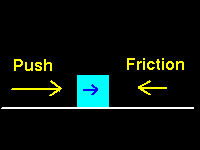 Thus, as we push the block of wood across the table, there are
two opposing forces that act: the force associated with the push,
and a force that is
associated with the friction and that acts in the opposite direction.
Galileo realized that as the frictional forces were decreased (for
example, by placing oil on the table) the object would move further and further
before stopping. From this he abstracted a basic form of
the law of inertia: if the
frictional forces could be reduced to exactly zero (not possible in a realistic
experiment, but it can be approximated to high precision)
an object pushed at constant speed
across a frictionless surface of infinite extent will continue at that speed
forever after we stop pushing, unless a new force acts on it at a later time.
Thus, as we push the block of wood across the table, there are
two opposing forces that act: the force associated with the push,
and a force that is
associated with the friction and that acts in the opposite direction.
Galileo realized that as the frictional forces were decreased (for
example, by placing oil on the table) the object would move further and further
before stopping. From this he abstracted a basic form of
the law of inertia: if the
frictional forces could be reduced to exactly zero (not possible in a realistic
experiment, but it can be approximated to high precision)
an object pushed at constant speed
across a frictionless surface of infinite extent will continue at that speed
forever after we stop pushing, unless a new force acts on it at a later time.
- Key aspect of methodology
 understanding
that ratios can lead to physical understanding as long as a consistent
measurement is done.
understanding
that ratios can lead to physical understanding as long as a consistent
measurement is done.
Galileo and the Church
Galileo's challenge of the Church's authority through his assault on the
Aristotelian conception of the Universe eventually got him into deep trouble
with the Inquisition. Late in his life he was
forced to
recant publicly his Copernican views
and spent his last years essentially under house arrest.
His story certainly constitutes one of the sadder examples of the conflict
between the scientific method and "science" based on unquestioned
authority. Unfortunately, there still are many forces in modern society that
would shackle the scientific method of open enquiry in ideological
chains of one kind or another.
Summarizing Aristotle's View
Aristotle held that there are two kinds of motion for inanimate matter, natural and unnatural. Unnatural (or
"violent") motion is when something is being pushed, and in this case the speed of motion is proportional to
the force of the push. (This was probably deduced from watching ox-carts and boats.) Natural motion is when
something is seeking its natural place in the universe, such as a stone falling, or fire rising. (We are only
talking here about substances composed of earth, water, air and fire, the "natural circular motion" of the
planets, composed of aither, is considered separately).
For the natural motion of heavy objects falling to earth, Aristotle asserted that the speed of fall was
proportional to the weight, and inversely proportional to the density of the medium the body was falling
through. He did also mention that there was some acceleration, as the body approached more closely its
own element, its weight increased and it speeded up. However, these remarks in Aristotle are very brief and
vague, and certainly not quantitative.
Actually, these views of Aristotle did not go unchallenged even in ancient Athens. Thirty years or so after
Aristotle's death, Strato pointed out that a stone dropped from a greater height had a greater impact on the
ground, suggesting that the stone picked up more speed as it fell from the greater height.
|
Galileo disputes all of Aristotle's ideas in a satirical manner:
Two New Sciences
Galileo set out his ideas about falling bodies, and about projectiles in general, in a book called "Two New
Sciences". The two were the science of motion, which became the foundation-stone of physics, and the
science of materials and construction, an important contribution to engineering.
The ideas are presented in lively fashion as a dialogue involving three characters, Salviati, Sagredo and
Simplicio. The official Church point of view, that is, Aristotelianism, is put forward by the character called
Simplicio, and usually demolished by the others. Galileo's defense when accused of heresy in a similar book
was that he was just setting out all points of view, but this is somewhat disingenuous---Simplicio is almost
invariably portrayed as simpleminded.
Salviati states:
I greatly doubt that Aristotle ever tested by experiment whether it be true that two stones, one weighing ten times
as much as the other, if allowed to fall, at the same instant, from a height of, say, 100 cubits, would so differ in
speed that when the heavier had reached the ground, the other would not have fallen more than 10 cubits.
This then marks the beginning of the modern era in science---the attitude that assertions about the
physical world by authorities, no matter how wise or revered, stand or fall by experimental test.
|
Galileo's Virtual Experiments (Go Here and Learn)
Galileo was an exacting experimentalist, fully aware of the value
of precise measurements and repeatable experimental detail:
Translated Quote from one of Galileo's Journals:
A piece of wooden moulding or scantling, about 12 cubits long, half a cubit wide, and three finger-breadths
thick, was taken; on its edge was cut a channel a little more than one finger in breadth; having made this groove
very straight, smooth, and polished, and having lined it with parchment, also as smooth and polished as
possible, we rolled along it a hard, smooth, and very round bronze ball. Having placed this board in a sloping
position, by raising one end some one or two cubits above the other, we rolled the ball, as I was just saying,
along the channel, noting, in a manner presently to be described, the time required to make the descent. We
repeated this experiment more than once in order to measure the time with an accuracy such that the deviation
between two observations never exceeded one-tenth of a pulse-beat. Having performed this operation and
having assured ourselves of its reliability, we now rolled the ball only one-quarter the length of the channel; and
having measured the time of its descent, we found it precisely one-half of the former. Next we tried other
distances, compared the time for the whole length with that for the half, or with that for two-thirds, or
three-fourths, or indeed for any fraction; in such experiments, repeated a full hundred times, we always found
that the spaces traversed were to each other as the squares of the times, and this was true for all inclinations
of the plane, i.e., of the channel, along which we rolled the ball. We also observed that the times of descent, for
various inclinations of the plane, bore to one another precisely that ratio which, as we shall see later, the Author
had predicted and demonstrated for them.
For the measurement of time, we employed a large vessel of water placed in an elevated position; to the bottom
of this vessel was soldered a pipe of small diameter giving a thin jet of water which we collected in a small glass
during the time of each descent, whether for the whole length of the channel or for part of its length; the water
thus collected was weighed, after each descent, on a very accurate balance; the differences and ratios of these
weights gave us the differences and ratios of the times, and this with such accuracy that although the operation
was repeated many, many times, there was no appreciable discrepancy in the results.
 Galileo Galilei (1564-1642) was a pivotal figure in the development of modern
astronomy, both because of his contributions directly
to astronomy, and because of his
work in physics and its relation to astronomy. He provided the crucial
observations that proved the Copernican hypothesis, and also laid the
foundations for a correct understanding of how objects moved on the surface of
the earth (dynamics) and of gravity.
Galileo Galilei (1564-1642) was a pivotal figure in the development of modern
astronomy, both because of his contributions directly
to astronomy, and because of his
work in physics and its relation to astronomy. He provided the crucial
observations that proved the Copernican hypothesis, and also laid the
foundations for a correct understanding of how objects moved on the surface of
the earth (dynamics) and of gravity.
 Galileo: the Telescope &
Galileo: the Telescope & 


 it does not appear that all of the objects in Aristotle's Universe are,
in fact, perfect. The moon has defects!
it does not appear that all of the objects in Aristotle's Universe are,
in fact, perfect. The moon has defects!


 Galileo observed the Sun through his telescope and saw that the
Sun had
dark patches on it that we now call sunspots
(he eventually
went blind, perhaps from damage suffered by looking at the Sun with his
telescope). Furthermore, he observed motion of the sunspots indicating that
the Sun was rotating on an axis. These "blemishes" on the Sun were contrary to
the doctrine of an unchanging perfect
substance in the heavens, and the rotation of the
Sun made it less strange that the Earth might rotate on an axis too, as
required in the Copernican model. Both represented new facts that were unknown
to Aristotle and Ptolemy.
Galileo observed the Sun through his telescope and saw that the
Sun had
dark patches on it that we now call sunspots
(he eventually
went blind, perhaps from damage suffered by looking at the Sun with his
telescope). Furthermore, he observed motion of the sunspots indicating that
the Sun was rotating on an axis. These "blemishes" on the Sun were contrary to
the doctrine of an unchanging perfect
substance in the heavens, and the rotation of the
Sun made it less strange that the Earth might rotate on an axis too, as
required in the Copernican model. Both represented new facts that were unknown
to Aristotle and Ptolemy.
 Galileo observed 4 points of light that changed their
positions with time
around the planet Jupiter on a nightly basis. He concluded that these were objects in
orbit around Jupiter. Indeed, they were the 4 brightest moons of Jupiter,
which are now
commonly called the Galilean moons (Galileo himself called them
the Medicea Siderea---the ``Medician Stars''). Here is a
simulation of the
system which approximates Galileo's field of view and the poor optics of
his telescope (which is why the images are not sharp).
Galileo observed 4 points of light that changed their
positions with time
around the planet Jupiter on a nightly basis. He concluded that these were objects in
orbit around Jupiter. Indeed, they were the 4 brightest moons of Jupiter,
which are now
commonly called the Galilean moons (Galileo himself called them
the Medicea Siderea---the ``Medician Stars''). Here is a
simulation of the
system which approximates Galileo's field of view and the poor optics of
his telescope (which is why the images are not sharp).



 Galileo used his telescope to show that Venus went
through a complete set of
phases, just like the Moon.
Galileo used his telescope to show that Venus went
through a complete set of
phases, just like the Moon. 


 Thus, as we push the block of wood across the table, there are
two opposing forces that act: the force associated with the push,
and a force that is
associated with the friction and that acts in the opposite direction.
Galileo realized that as the frictional forces were decreased (for
example, by placing oil on the table) the object would move further and further
before stopping. From this he abstracted a basic form of
the law of inertia: if the
frictional forces could be reduced to exactly zero (not possible in a realistic
experiment, but it can be approximated to high precision)
an object pushed at constant speed
across a frictionless surface of infinite extent will continue at that speed
forever after we stop pushing, unless a new force acts on it at a later time.
Thus, as we push the block of wood across the table, there are
two opposing forces that act: the force associated with the push,
and a force that is
associated with the friction and that acts in the opposite direction.
Galileo realized that as the frictional forces were decreased (for
example, by placing oil on the table) the object would move further and further
before stopping. From this he abstracted a basic form of
the law of inertia: if the
frictional forces could be reduced to exactly zero (not possible in a realistic
experiment, but it can be approximated to high precision)
an object pushed at constant speed
across a frictionless surface of infinite extent will continue at that speed
forever after we stop pushing, unless a new force acts on it at a later time.